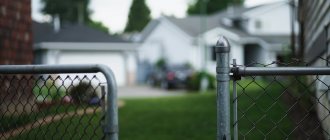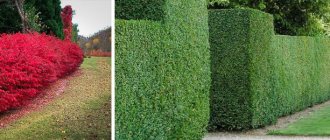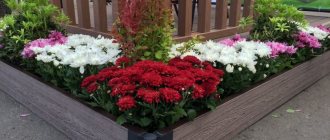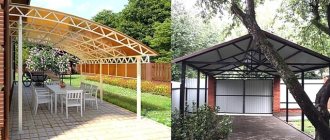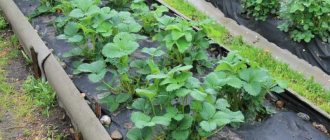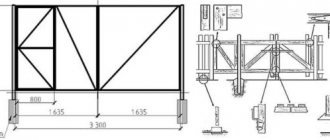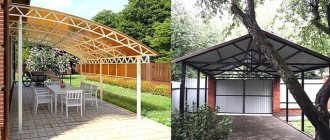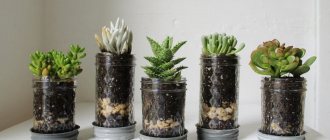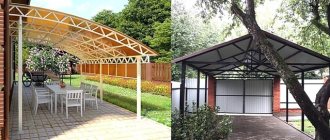When setting up a garden, we don’t always think about how it will look, and sometimes we forget that decorative fences for garden beds are not only a design element, but also an excellent tool in the fight against weeds and pests.
Increasingly, in dachas you can see fenced flower beds and beds. The tendency to install low fences in gardens and vegetable gardens is not new, but is now gaining popularity. This is not surprising, because fencing the beds in the greenhouse and in the open ground makes the area more well-groomed and clean.
Why do garden beds need fencing?
Perhaps you are now thinking about “fencing” the beds with fences and are already looking for suitable material for this. But first, let’s figure out why fences for beds and flower beds are needed in a dacha:
- plants in beds and flower beds will be protected from mechanical damage (for example, when mowing grass on the site);
- the number of weeds will decrease: the fence will make it difficult for them to germinate in the garden bed (especially if the sides are properly buried in the soil), which means there will be less weeding;
- the fence will prevent the beds from crumbling (this is important when loose sandy loam or sandy soil predominates on the site) or spreading after rain;
- fencing for high beds is necessary to form a box (an irreplaceable part of this type of beds), into which all components are then laid in layers;
- garden fences for beds will make the area more decorative: fenced beds look neater than beds without fences.
The materials from which fencing is made are quite varied. When choosing, focus on which material is more accessible to you (if you want to make a fence with your own hands), as well as on strength (if you buy it in a store).
Golden rules for planning bordered beds
Before you start implementing your design ideas, there are several important aspects to consider. To make flower beds delight the owners and make the plants comfortable, follow these principles:
- Harmony and unity of composition . Look around carefully. Evaluate what material the paths, house, and outbuildings are made of. In what style. Borders for flower beds should fit harmoniously into the overall style. Avoid heterogeneity, overload with colors and textures - it is better to experiment with form than with design elements of flower beds.
- Combination of plants and decoration . When creating fences, consider what garden plants will be placed in the designated area. Tall flowers and shrubs, including bush roses, require taller fences, but for miniature, groundcover or creeping crops, the borders should be kept low so as not to block the plants.
- Easy to care for . When creating fenced flower beds, it is necessary to provide for the possibility of watering, weeding and other agricultural work. Try to cut off cultivated plants from the lawn. To do this, use recessed sides, special fabric or tape that prevents the growth of weeds.
- Plant comfort . The place for the flower garden and fenced plantings must meet the needs of the selected ornamental crops in lighting, humidity, and soil fertility. For their full development and growth, the soil is carefully dug up and saturated with fertilizers, and an irrigation system is thought out.
- Constancy of location . Fenced areas are usually planned for a long time. The contents of the ridges and flower beds can change even every year, but the size, shape and placement remain unchanged. Therefore, you need to immediately provide convenient passages and optimal sizes so that you can freely care for the plantings and harvest.
Many gardeners prefer floral edging of flower beds, using low-growing foliage and floral ornamental species, for example, border roses
All these rules can be combined and expressed briefly: comfort for the eye, comfort for plants, comfort for people.
Plastic fencing for garden beds
One of the most popular materials is plastic. It does not absorb moisture, withstands weather changes well, is durable, and its cost is low. Fencing for plastic beds can be made in almost any form: in the form of a fence, flowers, bamboo stems, etc. This gives plastic garden fencing a decorative look.
Thanks to the flexibility and plasticity of the material, such fences can be safely used for beds of the most bizarre shapes. Fencing for beds made of plastic panels is optimal for placement in areas with loose, loose soil. Another advantage: to install a plastic panel for fencing beds, you do not need to dig a trench.
Selection rules
First of all, when choosing a border, you need to select the material. This parameter affects the duration of the fence, its texture and appearance. The following criteria are also :
- the cost of individual sections and the total costs of organizing the border;
- choosing a suitable solution for your own site, taking into account the landscape and surrounding buildings;
- the need to organize high beds or small elements up to 20 cm high;
- installation in a greenhouse or outdoors;
- Possibility of regular treatment or minimal care.
If you make the wrong choice, the border will not last long. It can be damaged by external factors such as precipitation and ultraviolet radiation. In addition, some models will have to be selected for the winter period, since the structure may be affected by excess moisture and excessive snow load.
Wooden fences for garden beds
Those who prefer environmental friendliness in everything will like this option. A fence for beds made of boards looks quite decorative, but for those who are used to doing everything “forever”, there is one significant drawback - such a “border” is relatively short-lived (7-10 years). For a mini-fence, you can use tree branches - they make nice wicker sides.
After some time, the wood will begin to rot, become covered with fungus and turn black. Neither whitewash will help here (it will be washed off by rain) nor paint (it will crack over time). Special protective agents (antiseptics) can extend the service life of wooden fencing.
Before installing a wooden fence, disinfect it with a solution of bleach: dilute 400 g of lime in 12 liters of water, leave for 4 hours, strain and spray the surface of the boards with the liquid.
Average price for different types
Before ordering borders for garden beds, you need to select a material taking into account your existing budget. Much depends on the choice of material and the size of individual structural elements.
As an initial design, you can take a standard curb 1 meter wide and 6 meters long. The following options are possible :
- When choosing stone borders 1 meter long, you will need 14 elements costing 170 rubles. As a result, the budget will be only 2380 rubles.
- When organizing a decorative plastic fence 2 meters long, you will need 7 elements, each of which costs 890 rubles. In total you will need 6230 rubles. In this case, no additional materials are required, since the fasteners are supplied included.
- If you choose a metal fence 3 meters long, you will need about 5 elements costing 1,650 rubles. In total you will need 8250 rubles.
The choice of material significantly affects the purchase budget. You can organize a budget solution or choose durable borders for your beds with a long service life.
Metal fencing for garden beds
When you decide to install metal fences for garden beds on your property, pay attention to what kind of metal they are made of. The best option is galvanized fencing for garden beds. Galvanized steel with a polymer coating withstands the vagaries of the weather well, the beds look neat.
Ready-made metal boxes for garden beds are lightweight, aesthetically pleasing and easy to install. Polymer fencing for garden beds (more precisely, with a polymer coating) does not rust, does not rot, and is not susceptible to fungal diseases and can serve you for 15-20 years. The polymer coating prevents the metal from getting too hot in the sun.
Pergones
Another option for fencing using natural stone is pergons. They are a mesh steel frame filled with stones. Other materials can also be used as filling: wood cuts, glass, broken brick .
Pergons are ideal for creating original flower beds, high beds, and retaining walls. This garden border is absolutely environmentally friendly and will not harm plants. If you use inexpensive filler, the cost of a mesh fence will be quite cheap, and installation will not take much time. Pergons do not require a foundation and can be installed on any surface.
Asbestos cement fencing for garden beds
Flat asbestos-cement slate is also an excellent material for fencing garden beds. One of the advantages of this design option is the availability and low cost of the material. In terms of durability, strips made from asbestos-cement sheets are practically not inferior to metal. Asbestos cement is not subject to rotting or burning, it is waterproof and durable.
It is also popular to fence beds with slate left over after completion of construction work on the site. Of course, old slate is not as durable as asbestos-cement sheets. If hit, it can easily break.
There is an opinion that the use of slate in the garden is dangerous for plants and human health. The fact is that some types of slate produced in European countries previously included amifol (now it is prohibited and is not used in production). Russian slate manufacturers use chrysotile instead of amifol - a safe substance. As a result of the confusion, a myth arose about the dangers of this material.
Wavy slate is dug into the soil to a depth of 40 cm - this will not only protect the beds from the invasion of weeds, but will also prevent pests (for example, mole crickets) from feasting on the roots of the plants.
Requirements and features
On the market you can find fences with decorative properties. They are available in specialized garden centers, but you can also find similar products in online stores. Products for garden beds have practical benefits.
The following functional differences can be distinguished:
- the growth and spread of weeds is limited;
- garden beds take on a neat appearance;
- when watering, the soil is retained in its original volume, which protects the fertile layer;
- cultivated plants are preserved in a limited area, forming a rational landscape;
- the ability of pests to move is reduced;
- watering becomes rational by choosing a certain amount of moisture for different plants.
An important point is simply covering with film. You can install arcs for a greenhouse, remove weeds and carry out weeding. With the right choice of components, you can create high or low beds and provide enough heat for sensitive crops.
DIY fences for garden beds
Everyone knows about the unfavorable environmental situation in the modern world. Plastic and other waste take decades and even centuries to decompose (the decomposition period of a typical plastic bottle is more than 100 years). Recycling plastic products is one of the measures necessary to maintain a healthy environment on the planet. Why not use the plastic bottles that have accumulated at the dacha as improvised material for fencing garden beds?
Fencing beds with bottles is quite simple: select bottles of approximately the same size and place them upside down in a pre-dug narrow trench. For strength, you can first pour a little sand into each bottle. Do you want your garden bed to look bright and colorful? Paint the bottoms of the bottles with water-based paint.
In fact, the material for fencing beds with your own hands can be anything (small stones, glass bottles, wooden pegs, etc.) - it all depends on imagination, possibilities and, of course, common sense.
What to make a border for a flower bed from
The answer to this question is extremely simple - from everything that your imagination tells you. Just look around and you will see dozens of ways to create original fences from scrap materials. Slate and boards, bricks and siding scraps, pebbles and cement, remnants of tiles and old dishes, even glass and plastic bottles can serve as practical design elements in the design of the site. Here are just a few ideas to help:
Slate
When purchasing old country houses, many are faced with the need to replace the roof. In this case, the removed slate is simply taken to a landfill. But it is very convenient to use for delimiting flower beds, beds or raspberry fields. The material can last for many more years, protecting the plantings from weeds. It is enough to cut the slate into pieces of 40-50 centimeters and dig them vertically along the perimeter of the flower beds. Even the ubiquitous raspberry shoots will not be able to break through such a fence, remaining in the territory allotted to them. Slate fragments will provide excellent drainage in areas prone to flooding.
Both the site is decorated and the nature is preserved - an excellent option in all respects!
Brick
If the house, bathhouse and gazebo are built of brick, then similar fences along the paths and flowerbed borders will fit perfectly into the overall style and add completeness to the composition. You can create “eternal” raised beds in several rows or lay out a herringbone fence, laying bricks on edge. A round flowerbed-well, occupied by hanging plants, will become a spectacular accent of the entrance group or decorate a fork in the paths; a wall-mounted version with climbing roses is an excellent solution for a blank wall.
Brick and stone flower beds are the most durable
The simplest installation methods can be done even without mortar
Tree
Perhaps wood remains the most affordable and easy-to-work material. Borders for garden beds can be made from boards, stump logs, and even branches after pruning in the garden. It is only important to take into account that wood rots when it comes into contact with wet soil, so it must first be protected from moisture using impregnation, paint or varnish.
Wooden structures are environmentally friendly and natural beauty, emphasizing the tenderness of flowering plants
More detailed recommendations on the use of wood when decorating flower beds on the site can be found in the article on our website
Available materials
The fantasy of summer residents is truly inexhaustible. They can turn almost anything into borders for flower beds and ridges:
- glass bottles have accumulated after a feast - here’s a new idea for fencing a flower bed;
- plastic “one and a half” and “five” without unnecessary complications become mini rockeries and unprecedented animals;
- a mini-fence is quickly constructed from scraps of plastic;
- old buckets, barrels, wheelbarrows, pots, kitchen utensils and even boots can easily be transformed into flowerpots and flower beds, creating stunning compositions on the veranda or lawn.
In a word, to create borders that delimit plantings on a site, absolutely any material that can withstand street conditions is suitable

